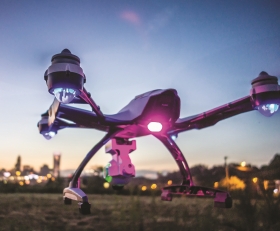

What was once just science fiction, along with artificial intelligence and driverless cars, surveillance drones are now very real and an affordable and effective video surveillance option. Here are the top reasons you should consider integrating a drone into your video management system.
1. Technology advancements
So why are we suddenly talking about drones? They’ve been around for quite some time, in fact military records go back to World War I in 1916. Mini and micro versions have been around since the early 90s. So, what’s changed?
Mainly capability and affordability. Over the last few decades, and more rapidly in the last few years, advancements in lighter and more powerful batteries and smaller camera technology has allowed for lighter payloads, which equates to lower cost and longer operating cycles.
When properly integrated with your VMS system, the consideration to use a drone is almost similar to adding a new PTZ camera to obtain longer range.
2. Dispatch to alarms
One of the most obvious and likely the highest value proposition of integrating a drone into your VMS system is the ‘Dispatch to Alarm’ capability. Most of today’s high-performance VMS systems are geospatial, or map-based.
Geospatial video management systems understand the physical location of security detection points, as well as real-time locations of detected intrusions from video cameras, radars, fence or proximity sensors. This allows it to easily dispatch a drone to an exact location using the geographical coordinate of the event.
The drone can arrive in a fraction of the time of a traditional response action to provide additional video of the event.
3. Flexible surveillance options
A drone can allow you to place a camera almost anywhere. This opens up many surveillance options.
You may have a region that is too rugged to allow cost-effective sensor placement; a drone can help monitor these regions. They can also respond to non-video sensor alarms, such as radar, GPS, fence systems or even remote access control. If visual confirmation is required, but there is no PTZ in the area with line of sight to the alarm, a drone can help service this request.
4. Airborne intelligence and tracking
Just as fixed cameras and PTZ cameras can be armed with intelligence via video analytics, on-board drone cameras can benefit from these same algorithms. As such, drones have the ability to detect intrusions, classify targets, count objects and alarm based on detection zones. This capability is available in both hover modes and while in flight.
5. After-breach continuous coverage
Deployment of PTZ follow algorithms on drone-based cameras allow for another significant capability: the ability to continue to follow the intruder after the breach. Keeping eyes on the target is critical, but even with a robust PTZ camera design, costs and viewshed issues can cause potential blind spots once the perimeter has been breached. In these cases, a drone can be deployed to provide coverage in these areas. Today’s micro and mini sized drones are capable of carrying a camera payload, meaning there are few locations which would not be accessible.
So how do I add a drone to my VMS?
Adding a drone to your surveillance solution can be as easy as placing an order on Amazon and getting your 2-day free shipping; however, much of the value proposition comes from proper integration with your VMS system. The includes being able to receive the live drone video directly into your VMS, automatic dispatch to an alarm location, display and tracking of the drone location, as well as the ability to issue basic drone commands directly from the VMS (Track Target, Begin Patrol, Return to Base, Land, etc.).
Eric Olson is vice president of marketing at PureTech Systems. Contact him at [email protected]
© Technews Publishing (Pty) Ltd. | All Rights Reserved.